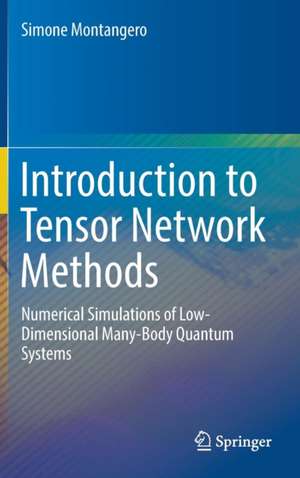Introduction to Tensor Network Methods: Numerical simulations of low-dimensional many-body quantum systems
Autor Simone Montangeroen Limba Engleză Hardback – 10 dec 2018
The book can be used for a graduate computational physics course. After successfully completing such a course, a student should be able to write a tensor network program and can begin to explore the physics of many-body quantum systems. The book can also serve as a reference for researchers working or starting out in the field.
Preț: 999.94 lei
Preț vechi: 1219.43 lei
-18% Nou
Puncte Express: 1500
Preț estimativ în valută:
191.33€ • 199.77$ • 158.36£
191.33€ • 199.77$ • 158.36£
Carte tipărită la comandă
Livrare economică 05-19 aprilie
Preluare comenzi: 021 569.72.76
Specificații
ISBN-13: 9783030014087
ISBN-10: 3030014088
Pagini: 150
Ilustrații: XV, 172 p. 41 illus., 30 illus. in color.
Dimensiuni: 155 x 235 mm
Greutate: 0.45 kg
Ediția:1st ed. 2018
Editura: Springer International Publishing
Colecția Springer
Locul publicării:Cham, Switzerland
ISBN-10: 3030014088
Pagini: 150
Ilustrații: XV, 172 p. 41 illus., 30 illus. in color.
Dimensiuni: 155 x 235 mm
Greutate: 0.45 kg
Ediția:1st ed. 2018
Editura: Springer International Publishing
Colecția Springer
Locul publicării:Cham, Switzerland
Cuprins
Introduction.- Part I: Software and Hardware.- Lesson 1: Computer for Physicists.- Lesson 2: Software for Physicists.- Part II: Crash Programming Course.- Lesson 3: Fortran.- Lesson 4: Python.- Lesson 5: Gnuplot.- Part III: Single-Body Problem.- Lesson 6: Matrix Diagonalization.- Lesson 7: Integrals.- Lesson 8: Differential Equations.- Part IV: Many-Body Problem.- Lesson 9: Monte Carlo.- Lesson 10: Renormalization Group.- Lesson 11: Tensor Networks.- Part V: Symmetries.- Lesson 12: Group Theory.- Lesson 13: Quantum Phase Transitions.- Lesson 14: Global Symmetries.- Lesson 15: Gauge Theories.
Notă biografică
Simone Montangero received his Ph.D. in theoretical physics from the University of Milano and the Habilitation in theoretical physics from the University of Ulm. He is now leading the line of research on quantum science and technology at the Department of Physics and Astronomy of University of Padova, where he is Full Professor since 2017. He has been a Heisenberg Fellow of the German Science Foundation, a Humboldt Fellow and he is an IQOQI visiting fellow of the Institute for Quantum Optics and Quantum Information of the Austrian Academy of Science. He has pioneered the development of tensor network methods for quantum technologies and the application of optimal control theory to many-body quantum systems. He has been one of the principal actors in the development and application of tensor networks for lattice gauge theories. He has been involved in several national and European projects and is a member of the Science and Engineering Board of the Quantum Flagship.
Textul de pe ultima copertă
This volume of lecture notes briefly introduces the basic concepts needed in any computational physics course: software and hardware, programming skills, linear algebra, and differential calculus. It then presents more advanced numerical methods to tackle the quantum many-body problem: it reviews the numerical renormalization group and then focuses on tensor network methods, from basic concepts to gauge invariant ones. Finally, in the last part, the author presents some applications of tensor network methods to equilibrium and out-of-equilibrium correlated quantum matter.
The book can be used for a graduate computational physics course. After successfully completing such a course, a student should be able to write a tensor network program and can begin to explore the physics of many-body quantum systems. The book can also serve as a reference for researchers working or starting out in the field.
The book can be used for a graduate computational physics course. After successfully completing such a course, a student should be able to write a tensor network program and can begin to explore the physics of many-body quantum systems. The book can also serve as a reference for researchers working or starting out in the field.
Caracteristici
Offers self-contained and course-tested lecture notes Describes the study of lattice gauge theories via tensor network methods for the first time Serves as a unique reference for computational physicists working in quantum science
